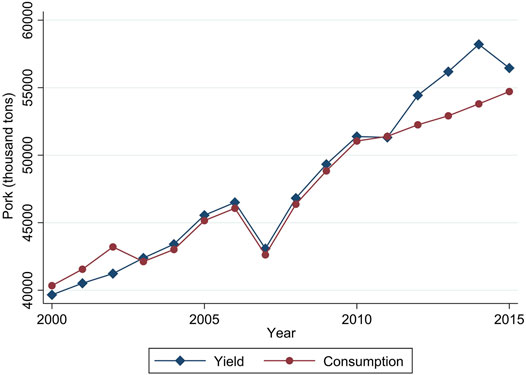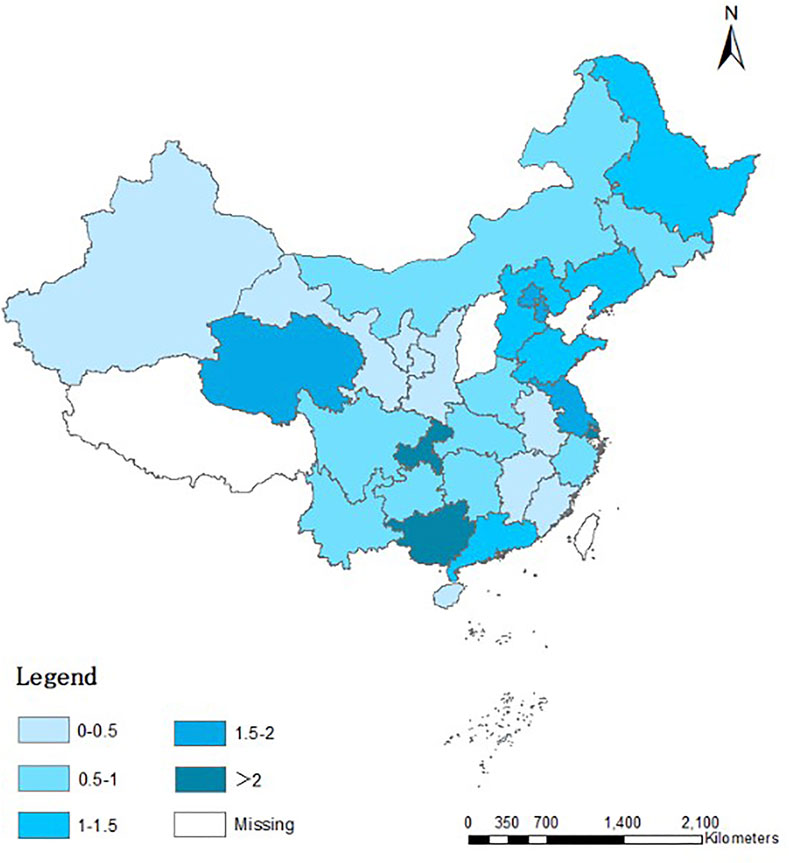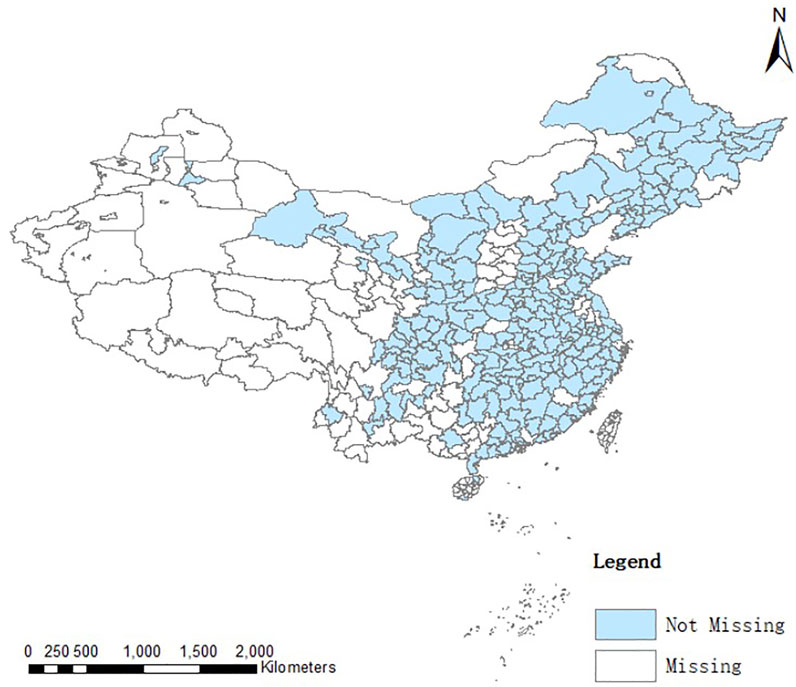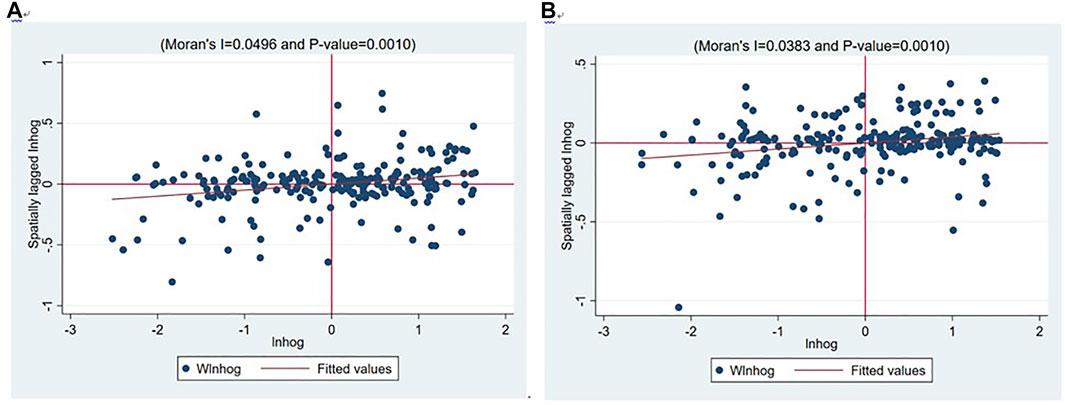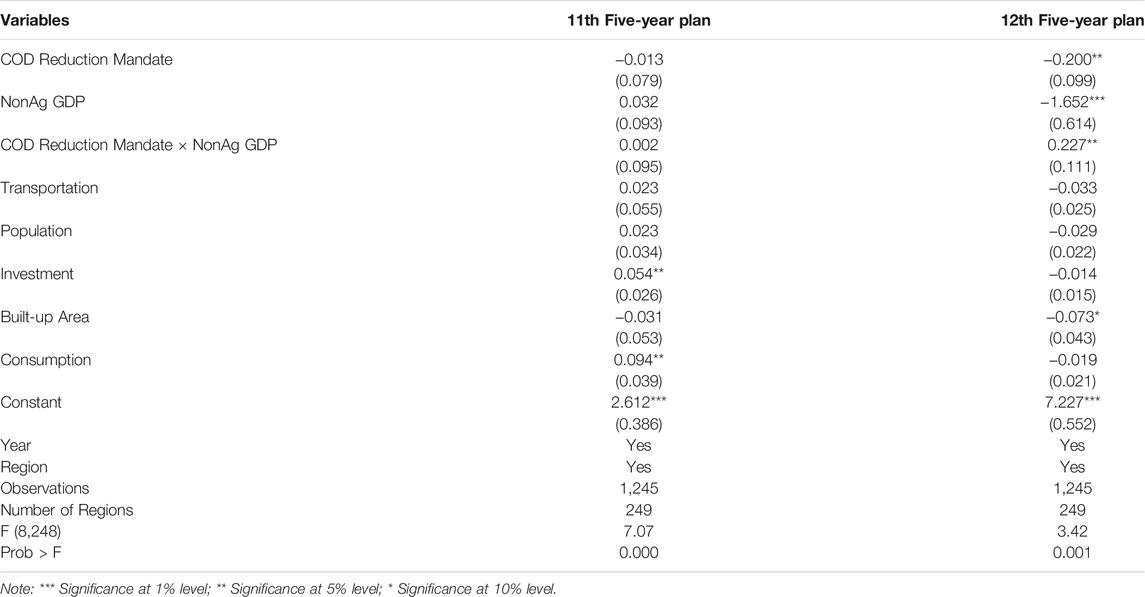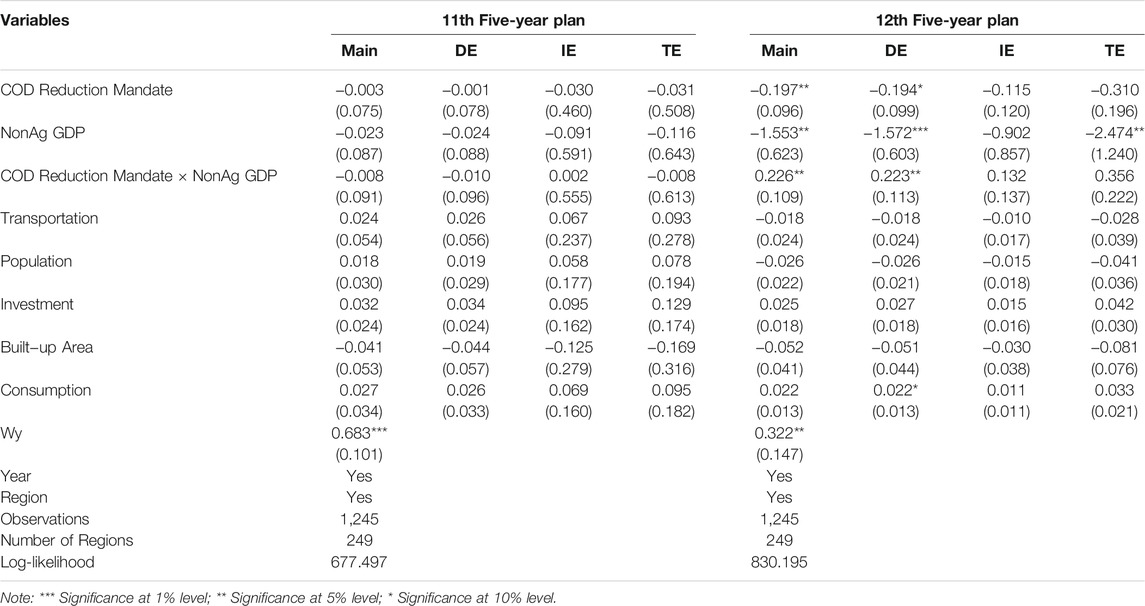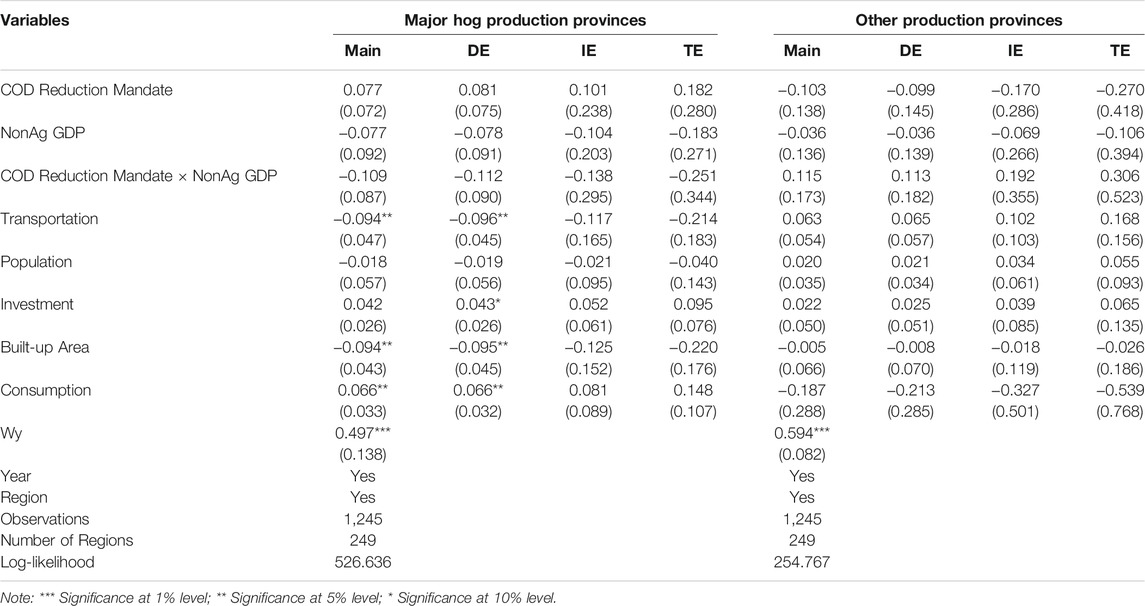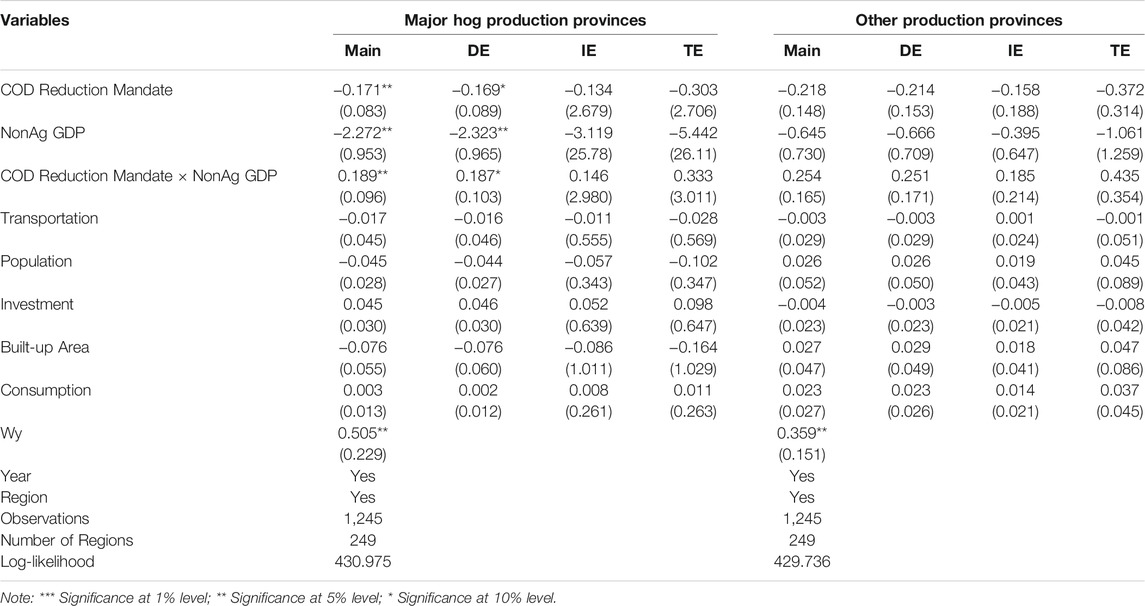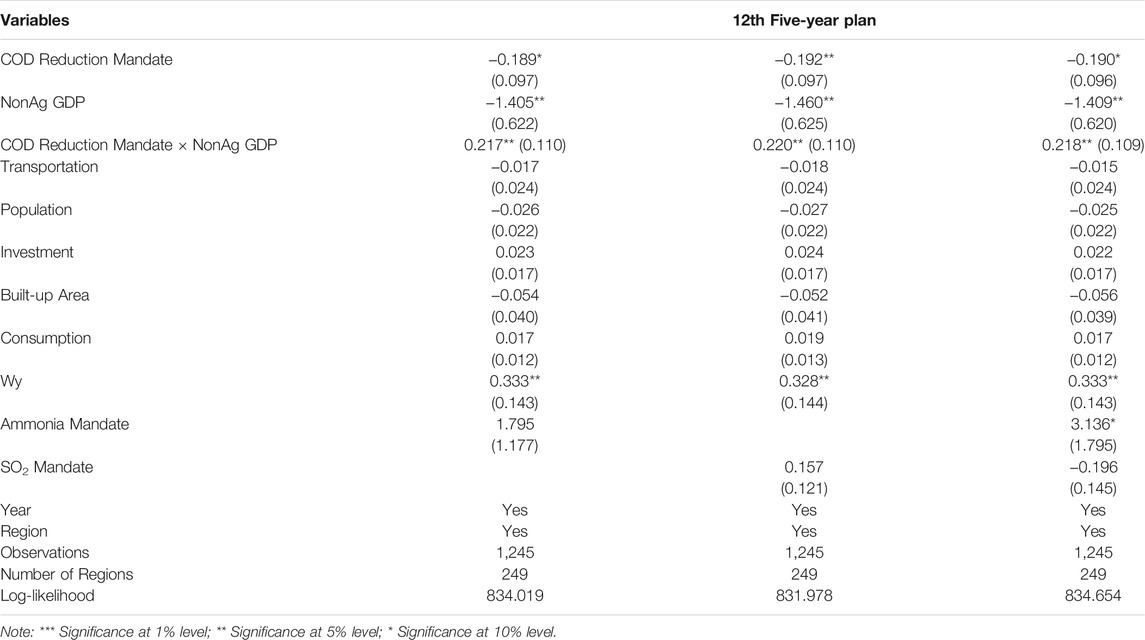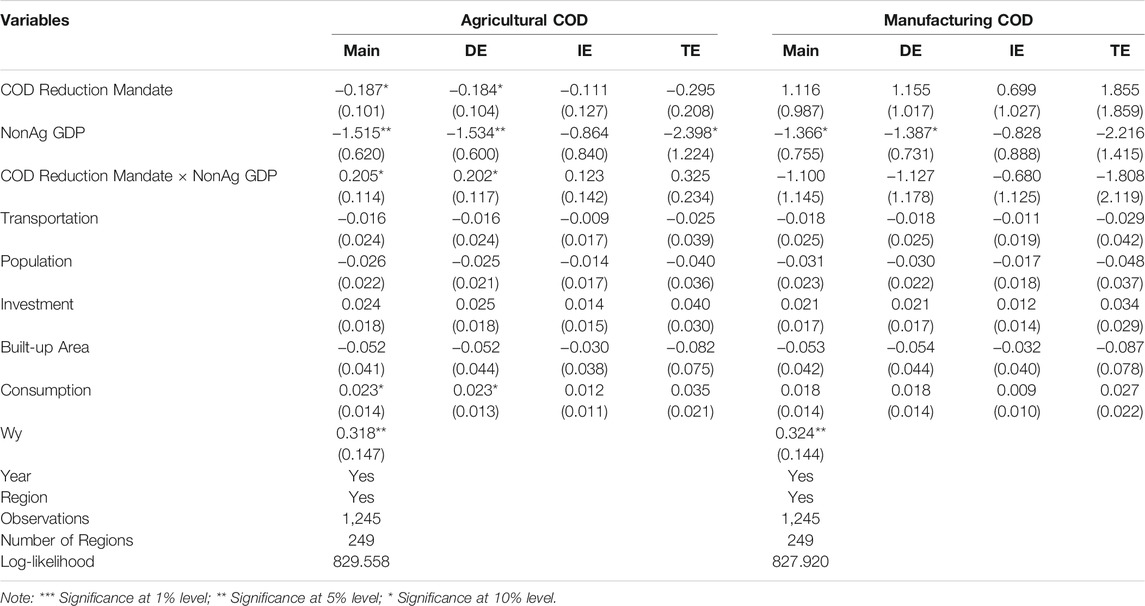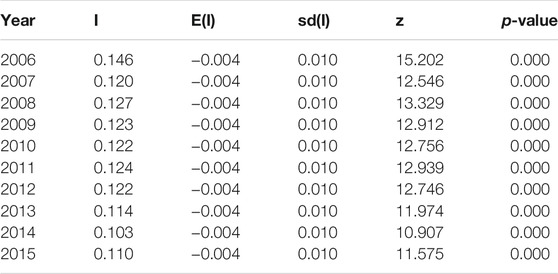- 1College of Economics and Management, South China Agricultural University, Guangzhou, China
- 2National School of Agricultural Institution and Development, South China Agricultural University, Guangzhou, China
Using a spatial econometric approach and national prefecture-level hog inventory data, this paper analyzes the extent to which environmental regulation policies influence hog production in China, and obtained the following research results: 1) During the 12th Five-Year Plan period, environmental regulation policies will significantly reduce the output of the hog industry in highly regulated areas. 2) The specific policy commands from the central government targeting on livestock sector and a high share of agriculture in the economy will increase the stringency of the environmental regulation policies on hog production. 3) The COD emission reduction requirements also have a significant negative impact on major hog farming provinces, the results obtained from the main model are verified again. The results highlight the importance of a more flexible environmental decentralization regime in China and other developing countries for future reforms.
Introduction
Whether strict environment regulation policy will cause negative impacts on production is a critical question in environmental economics and public policy. For developing countries, it is essential to balance economic development and environmental protection. Many studies have explored this question with respect to the industrial sector, including, but not limited to, how environmental regulation impacts firms’ productivity, output, and labor demand (Greenstone, 2002; Walker, 2013; Liu et al., 2017; Duflo et al., 2018). This topic is relatively less studied in the livestock sector even though large animal feeding operations are heavily monitored by environmental agencies, as they are among the primary sources for both water and air pollution (Sneeringer, 2010; Kling, 2011). The main pollutants produced by animal feeding are manure and exhaust gas, and the harmful components are mainly pathogenic microorganisms, organic nitrogen, ammonia, and carbon dioxide, these harmful components have direct toxic effects on humans (Yi et al., 2017).
Of all the agriculture-related sectors, hog production receives most scrutiny about its environmental impact on waterbodies worldwide. Both backyard and large-scale specialized operations can cause serious water pollution. Small farms usually have a lower production efficiency than the larger farms (Tauer and Mishra, 2006), which results in a higher implicit environmental cost given the amount of pork produced. Small farms are often classified as non-point sources, which makes it challenging to monitor their waste discharge behavior. Although large operations usually adopt more environment-friendly practices, their output can bring massive pressure on the environment (Pan et al., 2019). These large facilities that feed a large number of animals in limited areas generate an excessive amount of pollutants that potentially threaten the local water conditions. At the end of the 20th century, hog production and meat consumption increased sharply, which led to environmental pollution problems in many countries (Herath et al., 2005). Government regulations such as The European Union Nitrates Directive and the Concentrated Animal Feeding Operations rules in the U.S. have been introduced to monitor and control the pollution from hog production farms.
Environmental regulation is closely related to the concept of “external economy”. Marshall and Homans (2001) pointed out that externalities generally refer to unintentional side effects caused by individuals or enterprises to another party without compensation. The origin of environmental problems is the failure of the market mechanism in the allocation of environmental resources, and the reason for the failure is that the benefits caused by environmental pollution are exclusively enjoyed by the polluters, while the harm to society is borne by all members of society (Dahlman, 1979). At this time, the government needs to intervene with environmental regulation policies to compensate for market failures. Existing literature about the impact of environmental regulation on hog production focuses on developed regions, including the E.U (Gaigné et al., 2012; Mulatu and Wossink, 2014). and the U.S. (Metcalfe, 2001; Roe et al., 2002; Sneeringer and Key, 2011). Although these studies provide valuable insights into aspects of environmental regulation, they are not applicable to developing countries like China. In developed countries, the hog production market is dominated by industrialized operations. The share of total hog inventory of operations with 2,000 or more hogs is nearly 80% in the U.S. (Key and McBride, 2007).1 When faced with strict environmental regulation, these operations tend to adopt avoidance behaviors, including moving, downsizing, and slowing growth (Sneeringer and Key, 2011). In China, although hog farm size has been increasing, small- and mid-size farms are still important segments.2 As they have weak mobility and alternative potential income sources, when encountering regulation, small hog producers are inclined to stop operations instead of avoiding regulations like the large facilities do (Qiao et al., 2016; Zhang & Song, 2021). Moreover, because the monitoring on decentralized small farms is challenging, local governments may conduct more aggressive blunt force regulations, such as setting up “no-breeding zones” and shutting down the farms directly (Kamp, 2020; Qiu et al., 2021).
The second characteristic that distinguishes China from most developed countries is its unique environment regulation regime. Since the economic reforms in 1978, China has gradually established a complex system with the formal and informal distribution of authority between the central and local governments at different levels (Xu, 2011). Although the central government holds the ultimate political authority and legislation power, the local governments still have room to adjust their enforcement stringency and approach without compromising economic development and officials’ career prospects (Kahn et al., 2015). Various factors can impact the effectiveness of the regulation of hog production, including pressure from upper-level officials, local economic conditions, and career incentives of the responsible officials. Understanding the underlying mechanisms has important policy implications (Wu et al., 2022).
To bridge the gap in the literature, we studied the impact of water pollution regulation plans in China’s Five-Year Plans (FYPs) on hog production. We investigated the possible drivers that determine the differentiated stringency of environmental regulation under the general command from the central government. We collected data of year-end hog inventory from 249 prefectures in 29 provinces during the period 2006 to 2015, which covers the 11th (2006–2010) and 12th (2011–2016) FYPs. We constructed a measure of regulatory stringency based on each prefecture’s targets for Chemical Oxygen Demand (COD) reduction set by the upper government, following Chen et al. (2018). Our empirical evidence suggests that the environmental regulation targets set by the central government significantly reduced hog production in the studied period. With the increase of stringency by 0.1 standard deviation, the year-end inventory decreased by 0.9%–1.2%. We also found that the effectiveness of such regulation depends on the specific requirement from the central government and the specific socioeconomic conditions. We discuss the underlying motivation for local officials to enforce the regulation policies. We further use spatial econometrics models to capture the spatial dependencies among prefecture-level governments of neighboring regions. The implementation of specific regulatory policies on hog production might be influenced by the spillover of political knowledge from the neighboring regions (Zubek and Henning, 2016). Therefore, it is appropriate to apply spatial models, such as the spatial autoregressive model, to estimate the impact and drivers of the specific regulations.
Given the fundamental role of pork in Chinese society and the urgency to address pollution caused by hog production, our study is important for understanding the role of environmental regulation on hog production and to inform future policymaking not only in China but also in the small-scale animal production in other developing countries. This paper broadens the literature beyond developed countries and has comparatively more global relevance. Our research investigates the underlying drivers of environmental regulation and to what extent these factors and the stringency of policies control pollution. Building on the growing literature on environmental decentralization in developing countries (Van der Kamp et al., 2017; Duflo et al., 2018; Zhang et al., 2018; He et al., 2020), we discuss how this decentralized system affects livestock production in China. To our knowledge, this is the first paper to discuss the impact and mechanism of environmental regulation’s effects on the productivity of livestock sectors in developing countries.
The rest of the paper is organized as follows. Institutional Background describes the features of hog production in China and the country’s environmental regulation regime. Empirical Framework presents the empirical framework. Data Source and Measurement Construction introduces the data source and dataset construction. Results reports the regression results. Discussion and Policy Implications states conclusions and discusses policy implications.
Institutional Background
Hog Production in China
China is the world’s largest hog producer as well as consumer. Hog production is one of the most important sectors in China’s agricultural economy. A large amount of meat is consumed in the country (Yu and Abler, 2014). Among commodities, pork has the largest contribution to consumer price inflation (CPI) in China, equating to more than 6% (Yu, 2015). In summary, hog production is a crucial sector of the Chinese economy. From Figure 1, we can see that since 2000, pork production and consumption have increased steadily and rapidly with annual growth rate of 2.38 and 2.05%, respectively. The production centers have gradually moved away from the southeast coastal provinces to the inland regions (Tan et al., 2018), which is shown in Figure 2.
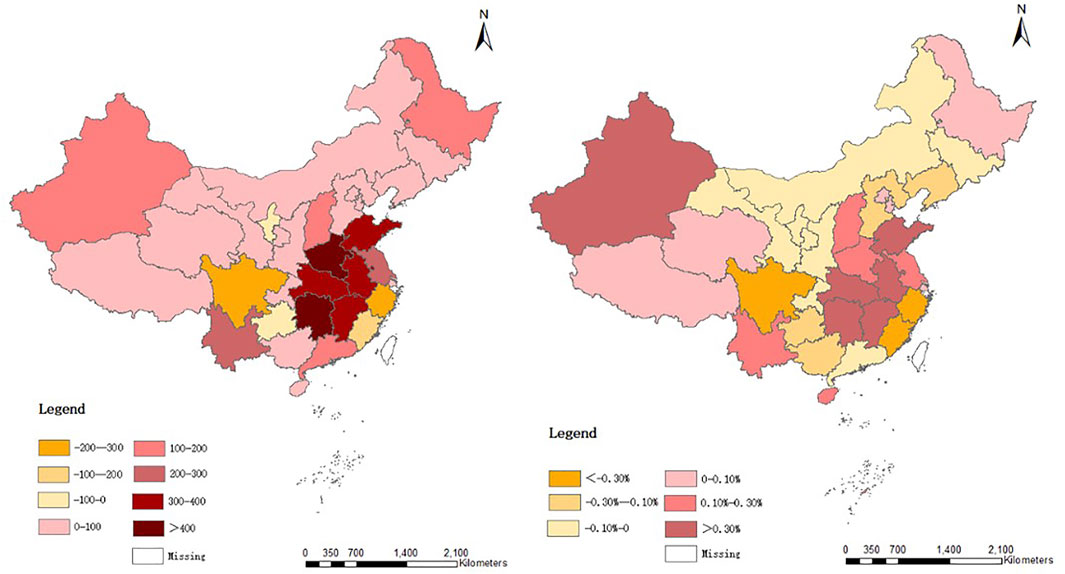
FIGURE 2. Changing trend of the hog inventory and environmental regulation stringency from 2006 to 2015. Note: First panel shows the changing quantity of hog inventory (10,000 heads) in each province and second panel shows the changing share of hog inventory for each province in the whole nation from 2006 to 2015, which was our study period.
China’s hog industry has undergone fundamental structural changes in the last decade. The most important transition has been in the market share of large-scale and specialized farms, which have grown significantly in the sector that was once purely dominated by small-scale, backyard operations (Gale et al., 2012; Xiao et al., 2012). With respect to the number of hogs slaughtered, the share of farms with more than 50 heads grew from 27% in 2002 to 69% in 2017. At the same time, many rural households abandoned hog farming. The main reason was the increased labor demand from non-farm sectors and the desire to improve the household environment (Qiao et al., 2016).3.
We can also observe other changes happening in the Chinese hog industry. For example, an increasing number of operations have been adopting socially-responsible and sustainable production practices, including using feed from renowned brands, using vaccination and drugs appropriately, and disposing of production waste by creating organic fertilizer (Ji et al., 2018a). Many reasons are believed to have led to such transformations, including larger farm size (Zhang et al., 2017), farmers’ cooperatives (Ji et al., 2019), and government policies (Chen and Yu, 2018; Qi et al., 2020). In recent years, environmental regulations related to water pollution have affected production and led to structural changes in hog production (Ji et al., 2018b). During the swine flu pandemic period in 2018, both central and local governments issued mandates that banned cross-boundary live hog or pork deliveries. Owing to the trade barriers among provinces, the spatially differentiated regulations caused unbalanced supply in different regions as the production became concentrated in provinces with lax regulations, which caused the dramatic increase of pork prices in many regions for the past 3 years.
Water Pollution Regulation on Hog Production
Since the economic opening up and reforms in 1978, China has established a decentralized system in which the local governments are accountable for environmental regulation enforcement within their jurisdiction, and the central government, specifically the Ministry of Environmental Protection (MEP), only sets the targets and guidance (Zheng and Kahn, 2013).4 Local officials prioritizing economic growth at the cost of environmental damage. The main reason behind this is that the promotions of officials hinge heavily on the economic performance during their term in China’s unique tournament-based hierarchy (Zhou, 2010; Li et al., 2019). Thus, decentralization leads to inadequate enforcement and insufficient implementation of the central government’s guidance.
To address the typical principal-agent problem, in the 11th FYP (2006–2010), the central government modified the evaluation standard for officials by binding the environmental targets (Kostka, 2016). The evaluation standard includes the power to punish or even demote local officials who fail to meet the requirements of pollution reduction (Sun et al., 2021a; Sun et al., 2021b). The central government sets the target for each province, and the provincial government assigns the burden of targets to prefecture-level governments based on the local conditions. Overall, the new environmental policy features “within-province policy” and uses promotion incentives to encourage environmental protection.
The 11th FYP contains the central government’s water pollution regulation targets relating to the reduction of COD emissions.5 The regulation requires provincial governments to reduce COD emission by at least 10% by the end of the 11th FYP. The policy emphasizes industrial/urban pollution sources. In the 12th FYP (2011–2015), a section was added to the regulation regarding reducing water pollution from agricultural and rural sources, especially from livestock facilities.6 In addition to the COD target, the 12th FYP added an NH3 reduction mandate as an indicator to control water pollution and assigned a specific target for each province. Each province will assign the specific target of each prefecture regarding how much COD emission they must reduce following the within-province allocation guideline issued by MEP (2006). As shown in Figure 3.
In addition to the general mandates for water pollution, the central government released the Prevention and Control of Pollution from Scaled Livestock and Poultry Farms policy in October 2013, which is the first specialized regulation targeting the pollution associated with the livestock sector, especially the scaled facilities. Following the central government, provincial governments implemented corresponding regulations. The main instruments that the local governments at multiple levels adopted were setting up no-breeding zones and closing down scaled farms that violated the mandates (Ji et al., 2018b). Unlike industrial or urban pollution, the regulations on livestock sectors require participation from not only the environmental protection departments but also the agricultural departments (Li, 2013).
Empirical Framework
The main objective of our empirical analysis is to identify the effect of central environmental regulation, specifically water pollution regulation, on the prefecture-level hog production. We assume that the hog production will decrease more, in absolute terms, in areas with more stringent targeted regulations compared with areas with relatively lax stringency. Specially, in the 11th FYP the regulation was not targeted on the general agricultural sectors and in the 12th FYP the regulation was added with an agricultural target. Meanwhile, the stringency was not uniform across cities. We consider the following empirical model to test the assumption:
where
A possible concern with the OLS-based model is that the spatial structures are ignored in the estimation. In particular, it was found in previous studies that spatial agglomeration factors can affect the intensity of livestock production (Roe et al., 2002; Isik, 2004; Gaigné et al., 2012). For example, the presence of one hog facility may promote the performance of the nearby facilities through spillovers of financial, technological, and market information. In addition, the local government may implement policies to encourage hog production if they observe the success of nearby prefectures. Similarly, if the local officials see that the stringent regulation of neighbors can have negative effects, such as financial loss due to reduced hog production, or positive effects, such as the promotion of officials since they follow closely the upper government, they may adjust their policy accordingly.
To overcome this issue, Following LeSage and Pace (2009) we introduce the spatial autoregressive (SAR) model, for our estimation. The SAR model assumes that the value of dependent variable in one prefecture affects the dependent value in nearby prefectures, which help us capturing the neighborhood spillover effects:
where
Data Source and Measurement Construction
The data collected for this study included prefecture-level hog production, measurements for environmental regulation stringency, and socioeconomic variables. Our data covered 249 prefectures in 29 provinces. Two provinces (Shanxi and Tibet) and some prefectures were excluded in the dataset because of missing data (Figure 4). During our study period from 2006 to 2015, the 249 prefectures accounted for 98% of the annual national gross hog inventory on average.8 For our analysis, we constructed a balanced panel dataset in which each observation represented a prefecture in a year. The following sections describe the 3 datasets in details.
The Prefecture-Level COD Reduction Mandate for Livestock Production
Measuring the stringency of environmental regulation is the main challenge when evaluating the consequences of environmental policies. It is challenging to quantify the stringency owing to its multi-dimensionality and simultaneity (Brunel and Levinson, 2016). The most commonly used measurement method relies on ex-post variables, including abatement costs (Keller and Levinson, 2002), actual levy fees (Dean et al., 2009; Wang et al., 2019), and emission level (Xing and Kolstad, 2002). However, because ex-post regulation measurements are more likely to be affected by the simultaneity issue, that is, production is the result of regulation, more studies have turned to ex-ante variables, such as utilizing natural experiment caused by discrete policy implementation (Greenstone, 2002; Liu et al., 2017) and target-based measurements (Damania et al., 2003; Wu et al., 2017; Chen et al., 2018).
Based on the nature of regulation of hog production in China, we followed the concept of Chen et al. (2018) to construct the measurement of stringency. Their approach is based on the MEP’s guidance (MEP, 2006), which includes an explicit rule for within-province allocation of COD reduction targets for each prefecture based on the past proportion of the prefecture’s COD emission in the whole province. However, in practice, COD emissions are not measured directly; officials usually estimate the value from the water-polluted production activities in the prefecture. As our research focuses on the regulation on the livestock sector, we utilized the output value of livestock production to construct the index of the relative stringency for each prefecture. Specifically,
The first term in
Hog Production
In this study, we used the head count of the inventory as an indicator of hog production.9 The outcome measure was the natural logarithm of the year-end hog inventory per prefecture. The data was collected from a wide variety of sources, including multiple provincial- and prefectural-level statistical yearbooks.10 For each prefecture included in the dataset, a unique code was generated that was used for merging other variables in the study.
Regional Characteristics
Information on regional socioeconomic characteristics that could influence the estimation but cannot be captured by prefecture and year fixed effects were included in this study. Of all the variables included, the most important one was the share of non-agricultural sector contribution in the prefecture’s total GDP (NonAg). As discussed above, unlike the industrial and urban sectors, both the environmental protection agency and the agricultural department play a key role for regulation on the livestock sector.
In general, a higher share of the agricultural sector in the whole economy is related to the associated department obtaining a greater capacity and budget in policy implementation in China’s decentralized fiscal system (Montinola et al., 1995). Meanwhile, under the tournament-style promotion system, it is reasonable to assume that a prefecture with a higher share of agriculture in the economy will receive more attention from the upper government (Li et al., 2019). Therefore, we included NonAg and its interaction term with regulation stringency in our model to investigate whether it impacted the implementation of environmental regulation.
Other regional characteristics were mainly collected from the Economic Prediction System (EPS) and the BRIC database. Following Metcalfe (2001) and Mulatu and Wossink (2014), we included time-varying characteristics that can impact hog production. These factors are access to markets and materials (surface area of transportation), labor availability (population density), capital availability (investment of fixed assets), land use (urban area), and market potential (total retail sales of consumer goods).
Summary statistics are presented in Table 1. Because we were interested in how differentiated regulation in the 11th and 12th FYPs can impact our estimation, the mean and standard deviation of all the variables are reported separately for all time, 11th FYP, and 12th FYP separately. No significant differences were detected between the 2 periods.
Results
Spatial Autocorrelation Test
As mentioned in the methodology section, ignoring the potential spatial relation in disturbances could lead to inefficient estimates. Therefore, before our main analyses, we first carry out Moran (1950), which is the most commonly used test for spatial autocorrelation, and proved the existence of spatial dependence. We conduct the test for the natural logarithm of the year-end hog inventory per prefecture in 2006 and 2015. To avoid the effect the outliers, we eliminate the prefectures with top and bottom 5% productions volume. Figure 5 displays the Moran’s I scatterplot. The calculated index for 2006 is 0.0496 and 0.0383 for 2015, both of which are significant at the 1% level.11 The results indicate the existence of spatial correlation in hog production, while not necessarily indicating any causal relationship. From the scatterplot, we can also see that the hog inventory in most prefectures had a positive relationship with the neighboring regions, showing the agglomeration effect in the hog industry.12.
Main Results
In Table 2, we present detailed estimated results for the fixed-effect model. As discussed above, the water pollution regulation in the 12th FYP had an important addition about the sources from agricultural sectors. Therefore, we estimate and report the model for the 2 periods separately.
The first variable of our interest is the COD reduction mandate. From Table 2, we can see the variable is negative and significant in the 12th FYP model but not in the 11th FYP, which means environmental regulation had a negative impact on hog production in the 12th FYP period but no effect in the 11th FYP period. In other words, the regulation effect only manifested when the central government added agricultural sources into the monitoring. In this OLS specification, the model result shows that during 12th FYP period, one-unit increase of the COD reduction mandate index is associated with a 2,000 head counts decrease of the year-end inventory. For the NonAg GDP variable, we found that there are significant and negative effects (direct and indirect) in the 12th FYP and no effects in the 11th FYP. Similar to the main variables, the interaction term between environmental regulation and NonAg GDP had no effect in the 11th FYP period but a positive and significant effect in the 12th FYP period. This shows that the stringency of environmental regulation was enhanced when the prefecture had a smaller non-agricultural sector, or larger agricultural sector.
To capture the potential spatial spillover effect from neighboring prefectures, we also estimate the SAR model as discussed above, the result of which is consistent with the OLS model. In addition to the coefficients, we also report the direct (DE), indirect (IE) and total effect (TE) in the table. The coefficient of Wy is significant, indicating the existence of spatial spillover. The direct effect of COD reduction mandate obtained, which display the effect of local environmental regulation on the dependent variable, is not significant in 11th FYP period and negative in the 12th FYP. The estimated scale is a little bit lower than the previous model (0.194 vs. 0.200). We observe similar patterns for other explanatory variables. This result reveals that the local reduction mandate was compromised through the feedback effects by the neighboring regions. For example, the stringent regulation may also reduce the hog production in neighboring prefectures that reversely promote the local stock. As is shown in Table 3.
Heterogeneous Treatment Effect
The previous section reports the average effects of water pollution regulation on hog production activities. We next test whether these effects varied with the size of production. From the main results, we can conclude that regions with a large agricultural sector may enhance the impact of environmental regulation. Therefore, we divide the sample into 2 groups: prefectures within major hog provinces and the rest of the provinces. We used 35 million heads slaughtered in 2018 as the cutoff point and defined the provinces above as the major hog production provinces. There were 8 such provinces: Sichuan, Henan, Hunan, Shandong, Hubei, Guangdong, Hebei, and Yunnan. Then, we estimated the SAR model separately as in the main results for the major hog production provinces and other provinces separately.
Similar to the main results, Table 4 reports the results for the 11th FYP and Table 5 reports the results for the 12th FYP. For the major hog production provinces, we find similar patterns as those for the main results shown in Table 3. However, for the other provinces, we found that the effect of environmental regulation and the interaction term were insignificant in both FYPs. This result further demonstrates that environmental regulation targeting hog production is more effective in regions where the sector is comparatively larger.
Effects of Other Environmental Regulation Indicators
As mentioned earlier, in the 12th FYP, the central government added NH3 reduction as the indicator for water pollution management. NH3 is produced from organic waste matter and can be toxic to aquatic animals at certain pHs and temperatures. Meanwhile, the MEP also assigns reduction mandate for SO2, which is the main indicator for air pollution. Like the COD reduction mandate, the central government assigns a specific target of the two pollutants for each province. We examine whether the co-existing regulation will alter our estimation.
Table 6 displays the results with controlling for NH3, SO2 and both indicators during 12th FYP, which are in column 1–3. For our variables of interest, namely the environmental regulation stringency, NonAg GDP, and their interaction term, the coefficients had the same significance and direction as the main model. The reduction mandate and NonAg GDP both were negative and significant, and their interaction term was positive and significant. Meanwhile, the coefficients of the two indicators are not significant for all models, showing that they play no significant role in the hog production regulation.
Alternative Stringency Measure
In addition to the COD reduction mandate, we used the livestock output value to construct the measurement of actual regulation stringency. As a robustness check, we use the output value of the whole agricultural and the industry sector to measure the regulation stringency following the similar method in Eq. 3. We re-run the analysis as we did in the main model. The result for the 11th FYP is similar to the main model that no variable of interests has significant value. The result for the 12th FYP is reported in Table 7.
When using the agricultural sector output value, we find similar pattern as the main model. The result further demonstrate that the size of the agricultural sector is the determine factor when assigning the reduction burden. When using the industry sector, as expected we find all the coefficients of interested variables are not significant. This placebo effect test show that other economic sectors are not impacting the hog production.
Discussion and Policy Implications
In Europe, hog production is concentrated in a few countries, with over two-thirds of the total inventory found in Germany, Spain, Poland, France, Denmark, and the Netherlands (Mulatu and Wossink, 2014). From the 1990s onward, E.U. environmental policies have started to overrule national measures with the nitrate directive, which was issued in 1991. The directive provides guidance on how E.U. countries should deal with the nitrate problem specifically from livestock sectors. In the United States, hog industry also has undergone dramatic structural changes over the past 3 decades, environmental policies that have been applied to livestock are directed generally toward larger, incorporated, or vertically integrated operations (Park et al., 2002). In 1998, 23 U.S. states and the federal government considered legislation to monitor more closely emissions from livestock operations, these policies tend to address ground and surface water concerns and, increasingly, air quality issues. Despite China’s recent environmental regulations receiving much attention, not many studies have addressed the effects of the regulations on China’s hog industry, which is an unneglectable source of environmental pollution.
Our empirical analysis found that environmental regulations can cause a significant and negative impact on hog production in China. Using a spatial econometric approach and national prefecture-level hog inventory data, our study fills a gap in the literature on agri-environmental regulation policies in developing countries.13 We also discussed the underlying dynamics of the prefecture-level governments’ stringency of implementing environmental regulations. On the one hand, the authority of regulation is granted to the local government by the central government. Therefore, the prefectural government must follow the general rules set up by the central government. On the other hand, China has a de facto decentralized governing system in which officials adjust the regulation level based on local conditions. Our empirical results reveal the mechanisms of and provide insights on the logic of local government behaviors.
The first pattern we observe is that the regulation on hog production was only effective in the 12th FYP and not in the 11th FYP, even though they shared similar COD reduction target requirements for prefectural governments. We believe such a difference is due to the addition of the policy on agricultural pollution sources in the 12th FYP document and the specific legislation on livestock pollution. Although many studies discuss environmental federalism in China (Cai et al., 2016), the focus of the central government is undoubtedly the strongest driver of environmental regulation. For example, Zhang et al. (2018) found that the supervision of the central government significantly enhanced the stringency of local environmental regulation. In the political tournament system of China (Zhou, 2010), the central government makes the final decision about the promotion based on whether they met the requirements set by the upper government. In our case, because the 11th FYP only mentioned industrial/urban pollution in the reduction plan, the prefectural government possibly lacked the motivation to reduce the pollution from the hog industry. However, the situation changed drastically in the 12th FYP. This result still holds when we used NH3 as the indicator, showing that it is not sensitive to the selection of the water pollution index.
However, as mentioned earlier, local officials have room in the implementation of policies, especially environmental regulation that targets certain sectors. Our primary and heterogeneous results both show that the stringency of environmental regulation was higher in regions where the agricultural sector generates a substantial share of the GDP. We have two possible explanations for this phenomenon. First, following from the previous pattern that we observed, the major production regions may receive extra attention from the upper government. In the documents of the Chinese government, the focus areas for policy implementation and the key elements for evaluating the overall performances are stated.14 The second possible explanation is that for the specific regulations on hog production, the capacity of the agricultural department is vital, which is often decided by the size of the prefectural agricultural economy. Without enough budget or human resources, the local agricultural department may not be able to regularly conduct complex monitoring and manage pollution sources, such as distributed backyard hog farmers (Kostka, 2016).
The balancing of pork meat security and water pollution management will be a pressing issue in the future food policy of China. To incentivize local governments to implement sustainable and practical regulations, a more flexible regime should be provided in which the lower-level governments can adapt the stringency or method based on their strengths and weaknesses. For regions with weak regulatory capacity but severe water pollution problems, the central government should allocate more public investment to help the localities to solve their environmental issues. For the major hog production areas, the central government should drop excessive requirements; otherwise, the radical reduction of hog production may cause unnecessary volatility in the pork market. In conclusion, efficient and effective coordination between the central and local governments will be essential for successful agri-environmental policy design and implementation. In further work, we believe that the research on environmental regulation of China’s hog production needs to pay attention to the changes in the spatial layout of farms. China’s hog industry is still in the adjustment stage, and the geographical space layout will continue to be adjusted in the future. How to make The industrial space layout is more reasonable, and which areas are planned as breeding production areas deserves more exploration. In addition, we believe that the environmental regulation policies can continue to be extended to micro-investigation, so that we can more clearly understand the demands of hog farmers, and understand the impact of factors such as personal characteristics, market distance, and land property rights on the perception of environmental regulation policies.
Data Availability Statement
The raw data supporting the conclusion of this article will be made available by the authors, without undue reservation.
Author Contributions
FZ contributed to the motivation, the interpretation of the methods, the data analysis and results, and provided the draft versions and revised versions, references. LY provided the data and results, the revised versions and references. YT provided the related concepts and minor recommendations, extracted the conclusion and discussion.
Funding
This work was supported by National Science Foundation of China (71973046), Natural Science Foundation of Guangdong (2019A1515011479).
Conflict of Interest
The authors declare that the research was conducted in the absence of any commercial or financial relationships that could be construed as a potential conflict of interest.
Publisher’s Note
All claims expressed in this article are solely those of the authors and do not necessarily represent those of their affiliated organizations, or those of the publisher, the editors and the reviewers. Any product that may be evaluated in this article, or claim that may be made by its manufacturer, is not guaranteed or endorsed by the publisher.
Footnotes
1In the U.S., the environmental regulation on hog production is often size-based, given the structure of the production-side market
2In China, farms with fewer than 50 heads of hogs are regarded as small, and those with 50–499 heads are regarded as mid-size.
3According to the data collected from Ministry of Agriculture, in 2016 the per-head production cost is 1,718 yuan, among which the material cost including feed is 1,383 and labor cost is 333. With more large-scale facilities entering in the market, the hog production is becoming more intellectual- and capital-intensive while requires less labor input compared with the traditional method
4The name of the ministry was changed to Ministry of Environmental and Ecology in 2018
5The document is the reduction plan of COD emissions for provincial governments during the 11th FYP. It was issued by the State Council. It assigns the total COD reduction targets for each province
6This document has a similar structure to the 11th FYP plan and assigns targets for each province
7Pork-cycle and infectious swine diseases are important factors determining pork price. Since the Chinese pork market is highly integrated and these factors often manifest as a national shock, the fixed effects in the model will capture their influence on hog production
8The national hog production data was collected from the website of the National Bureau of Statistics
9Year-end inventory is the most widely used proxy for hog production, as it reflects the stable capacity of farms. The number of hogs slaughtered can also be used as a proxy. However, we think the inventory is preferable, as the number of hogs slaughtered can be impacted by temporary shocks, for example, a major infectious disease event
10Unlike other general socioeconomic information, such as GDP and population, data on prefecture-level hog production is not recorded consistently in the provincial-level official statistical yearbook. For some provinces, we had to search the prefecture-level statistical yearbook to find such information
11Test results are robust for each year throughout our study period for the full sample. The detailed information is shown in Table A1.
12The fitted values and most data points in the scatterplot lie in the first and third quadrant in the graph, which means high-production regions often have high-production neighbors
13The only study covering a similar topic is Ji et al. (2018b), which utilized the DID framework and county-level data (502 counties). They identified the negative impact of environmental regulation on hog production, which is consistent with our findings
14For example, in 2017, the Ministry of Agriculture issued the National Hog Production Plan that listed in detail that the previous major hog production provinces should limit or even reduce the production to protect the local water resources
References
Brunel, C., and Levinson, A. (2016). Measuring the Stringency of Environmental Regulations. Rev. Environ. Econ. Pol. 10, 47–67. doi:10.1093/reep/rev019
Cai, H., Chen, Y., and Gong, Q. (2016). Polluting Thy Neighbor: Unintended Consequences of China׳s Pollution Reduction Mandates. J. Environ. Econ. Manag. 76, 86–104. doi:10.1016/j.jeem.2015.01.002
Chen, Y., and Yu, X. (2018). Does the Centralized Slaughtering Policy Create Market Power for Pork Industry in China. China Econ. Rev. 50, 59–71. doi:10.1016/j.chieco.2018.03.005
Chen, Z., Kahn, M. E., Liu, Y., and Wang, Z. (2018). The Consequences of Spatially Differentiated Water Pollution Regulation in China. J. Environ. Econ. Manag. 88, 468–485. doi:10.1016/j.jeem.2018.01.010
Damania, R., Fredriksson, P. G., and List, J. A. (2003). Trade Liberalization, Corruption, and Environmental Policy Formation: Theory and Evidence. J. Environ. Econ. Manag. 46, 490–512. doi:10.1016/s0095-0696(03)00025-1
Dean, J. M., Lovely, M. E., and Wang, H. (2009). Are Foreign Investors Attracted to Weak Environmental Regulations? Evaluating the Evidence from China. J. Dev. Econ. 90, 1–13. doi:10.1016/j.jdeveco.2008.11.007
Duflo, E., Greenstone, M., Pande, R., and Ryan, N. (2018). The Value of Regulatory Discretion: Estimates from Environmental Inspections in India. Econometrica 86, 2123–2160. doi:10.3982/ecta12876
Gaigné, C., Le Gallo, J., Larue, S., and Schmitt, B. (2012). Does Regulation of Manure Land Application Work against Agglomeration Economies? Theory and Evidence from the French Hog Sector. Am. J. Agric. Econ. 94, 116–132. doi:10.1093/ajae/aar121
Gale, F., Hu, D., and Marti, D. (2012). China’s Volatile Pork Industry. Washington, DC: United States Department of Agriculture.
Greenstone, M. (2002). The Impacts of Environmental Regulations on Industrial Activity: Evidence from the 1970 and 1977 Clean Air Act Amendments and the Census of Manufactures. J. Polit. Economy 110, 1175–1219. doi:10.1086/342808
He, G., Wang, S., and Zhang, B. (2020). Watering Down Environmental Regulation in China. Q. J. Econ. 135, 2135–2185. doi:10.1093/qje/qjaa024
Herath, D. P. B., Weersink, A., and Carpentier, C. L. (2005). Spatial Dynamics of the Livestock Sector in the united states: Do Environmental Regulations Matter. J. Agric. Resource Econ. 30 (1), 45–68. doi:10.1016/j.foodpol.2005.02.003
Isik, M. (2004). Environmental Regulation and the Spatial Structure of the U.S. Dairy Sector. American Am. J. Agric. Econ. 86, 949–962. doi:10.1111/j.0002-9092.2004.00645.x
Ji, C., Chen, Q., Trienekens, J., and Wang, H.-t. (2018a). Determinants of Cooperative Pig Farmers' Safe Production Behaviour in China - Evidences from Perspective of Cooperatives' Services. J. Integr. Agric. 17, 2345–2355. doi:10.1016/s2095-3119(18)62058-1
Ji, C., Chen, S., and Jin, S. (2018b). Impact Evaluation of “Regulation on Water Pollution from Livestock and Poultry Production” --the Case of Livestock Sector in China. Washington,D.C.
Ji, C., Jin, S., Wang, H., and Ye, C. (2019). Estimating Effects of Cooperative Membership on Farmers' Safe Production Behaviors: Evidence from Pig Sector in China. Food Policy 83, 231–245. doi:10.1016/j.foodpol.2019.01.007
Kahn, M. E., Li, P., and Zhao, D. (2015). Water Pollution Progress at Borders: The Role of Changes in China's Political Promotion Incentives. Am. Econ. J. Econ. Pol. 7, 223–242. doi:10.1257/pol.20130367
Kamp, D. S. (2020). Blunt Force Regulation and Bureaucratic Control: Understanding China’s War on Pollution. Governance gove 34, 191–209. doi:10.1111/gove.12485
Keller, W., and Levinson, A. (2002). Pollution Abatement Costs and Foreign Direct Investment Inflows to U.S. States. Rev. Econ. Stat. 84, 691–703. doi:10.1162/003465302760556503
Key, N., and McBride, W. D. (2007). The Changing Economics of U.S. Hog Production (No. 54). Washington,DC: U.S. Department of Agriculture, Economic Research Service.
Kling, C. L. (2011). Economic Incentives to Improve Water Quality in Agricultural Landscapes: Some New Variations on Old Ideas. Am. J. Agric. Econ. 93, 297–309. doi:10.1093/ajae/aaq190
Kostka, G. (2016). Command without Control: The Case of China's Environmental Target System. Regul. Governance 10, 58–74. doi:10.1111/rego.12082
LeSage, J. P., and Pace, R. K. (2009). Introduction to Spatial Econometrics. Boca Raton, FL: Taylor & Francis Group.
Li, X., Liu, C., Weng, X., and Zhou, L.-A. (2019). Target Setting in Tournaments: Theory and Evidence from China. Econ. J. 129, 2888–2915. doi:10.1093/ej/uez018
Liu, M., Shadbegian, R., and Zhang, B. (2017). Does Environmental Regulation Affect Labor Demand in China? Evidence from the Textile Printing and Dyeing Industry. J. Environ. Econ. Manag. 86, 277–294. doi:10.1016/j.jeem.2017.05.008
Marshall, E. P., and Homans, F. R. (2001). Using Optimal Control to Characterize the Economic and Ecological Implications of Spatial Externalities. 2001 Annual Meeting, August 5-8. Chicago, IL: American Agricultural Economics Association.
Mep, (2006). The Guidelines for the Allocation of the Total Emissions of the Major Water Pollutants. Beijing, China: Ministry of Environmental Protection.
Metcalfe, M. (2001). U.S. Hog Production and the Influence of State Water Quality Regulation. Can. J Agric Econ 49, 37–52. doi:10.1111/j.1744-7976.2001.tb00289.x
Montinola, G., Qian, Y., and Weingast, B. R. (1995). Federalism, Chinese Style: the Political Basis for Economic success in China. World Pol. 48, 50–81. doi:10.1353/wp.1995.0003
Moran, P. A. P. (1950). Notes on Continuous Stochastic Phenomena. Biometrika 37, 17–23. doi:10.1093/biomet/37.1-2.17
Mulatu, A., and Wossink, A. (2014). Environmental Regulation and Location of Industrialized Agricultural Production in Europe. Land Econ. 90, 509–537. doi:10.3368/le.90.3.509
Pan, D., Yang, J., Guo, Q., Lu, Q., and Zhang, N. (2019). Toward Better Environmental Performance in Hog Production in China: Is Intensification the Answer. Ecol. Indicators 105, 347–354. doi:10.1016/j.ecolind.2017.11.001
Park, D., Seidl, A., and Davies, S. (2002). Environmental Policy and Industry Location: The Case of the U.S. Livestock Industry. Rev. Reg. Stud. 32 (9), 837–845. doi:10.52324/001c.8459
Qi, D., Lai, W., and Roe, B. E. (2020). Food Waste Declined More in Rural Chinese Households with Livestock. Food Policy 98, 101893. doi:10.1016/j.foodpol.2020.101893
Qiao, F., Huang, J., Wang, D., Liu, H., and Lohmar, B. (2016). China's Hog Production: From Backyard to Large-Scale. China Econ. Rev. 38, 199–208. doi:10.1016/j.chieco.2016.02.003
Qiu, S., Wang, Z., and Geng, S. (2021). How Do Environmental Regulation and Foreign Investment Behavior Affect green Productivity Growth in the Industrial Sector? an Empirical Test Based on Chinese Provincial Panel Data. J. Environ. Manage. 287, 112282. doi:10.1016/j.jenvman.2021.112282
Roe, B., Irwin, E. G., and Sharp, J. S. (2002). Pigs in Space: Modeling the Spatial Structure of Hog Production in Traditional and Nontraditional Production Regions. Am. J. Agric. Econ. 84, 259–278. doi:10.1111/1467-8276.00296
Sneeringer, S. (2010). A National, Longitudinal Study of the Effects of Concentrated Hog Production on Ambient Air Pollution. Am. J. Agric. Econ. 92, 821–835. doi:10.1093/ajae/aap030
Sneeringer, S., and Key, N. (2011). Effects of Size-Based Environmental Regulations: Evidence of Regulatory Avoidance. Am. J. Agric. Econ. 93, 1189–1211. doi:10.1093/ajae/aar040
Li, K, and State Council, (2013). Prevention and Control of Pollution from Scaled Livestock and Poultry Farms (No. 643).
Sun, H., Awan, R. U., Nawaz, M. A., Mohsin, M., Rasheed, A. K., and Iqbal, N. (2021a). Assessing the Socio-Economic Viability of Solar Commercialization and Electrification in South Asian Countries. Environ. Dev. Sustain. 23, 9875–9897. doi:10.1007/s10668-020-01038-9
Sun, H., Edziah, B. K., Kporsu, A. K., Sarkodie, S. A., and Taghizadeh-Hesary, F. (2021b). Energy Efficiency: the Role of Technological Innovation and Knowledge Spillover. Technol. Forecast. Soc. Change 167, 120659. doi:10.1016/j.techfore.2021.120659
Tan, Y., Hu, H., and Zhou, J. (2018). Influence Mechanism of Regional Environmental Regulation on Pig Breeding and Production. Jiangsu Agricultural Science. 13, 347–352. doi:10.15889/j.issn.1002-1302.2018.13.080
Tauer, L. W., and Mishra, A. K. (2006). Can the Small Dairy Farm Remain Competitive in US Agriculture. Food Policy 31, 458–468. doi:10.1016/j.foodpol.2005.12.005
Van der Kamp, D., Lorentzen, P., and Mattingly, D. (2017). Racing to the Bottom or to the Top? Decentralization, Revenue Pressures, and Governance Reform in China. World Dev. 95, 164–176. doi:10.1016/j.worlddev.2017.02.021
Walker, W. R. (2013). The Transitional Costs of Sectoral Reallocation: Evidence from the Clean Air Act and the Workforce*. Q. J. Econ. 128, 1787–1835. doi:10.1093/qje/qjt022
Wang, X., Zhang, C., and Zhang, Z. (2019). Pollution haven or porter? the Impact of Environmental Regulation on Location Choices of Pollution-Intensive Firms in China. J. Environ. Manage. 248, 109248. doi:10.1016/j.jenvman.2019.07.019
Wu, H., Guo, H., Zhang, B., and Bu, M. (2017). Westward Movement of New Polluting Firms in China: Pollution Reduction Mandates and Location Choice. J. Comp. Econ. 45, 119–138. doi:10.1016/j.jce.2016.01.001
Wu, B., Liang, H., and Chan, S. (2022). Political Connections, Industry Entry Choice and Performance Volatility: Evidence from China. Emerging Markets Finance and Trade 58 (1), 290–299. doi:10.1080/1540496x.2021.1904878
Xiao, H., Wang, J., Oxley, L., and Ma, H. (2012). The Evolution of Hog Production and Potential Sources for Future Growth in China. Food Policy 37, 366–377. doi:10.1016/j.foodpol.2012.02.002
Xing, Y., and Kolstad, C. D. (2002). Do lax Environmental Regulations Attract Foreign Investment. Environ. Resour. Econ. 21, 1–22. doi:10.1023/a:1014537013353
Xu, C. (2011). The Fundamental Institutions of China's Reforms and Development. J. Econ. Lit. 49, 1076–1151. doi:10.1257/jel.49.4.1076
Yi, Q., Song, K., Tao, H., and Ying, T. (2017). Environmental Status of Livestock and Poultry Sectors in china under Current Transformation Stage. Sci. Total Environ. 622-623, 702. doi:10.1016/j.scitotenv.2017.12.045
Yu, X., and Abler, D. (2014). Where Have All the Pigs Gone? Inconsistencies in Pork Statistics in China. China Econ. Rev. 30, 469–484. doi:10.1016/j.chieco.2014.03.004
Yu, X. (2015). Meat Consumption in China and its Impact on International Food Security: Status Quo, Trends, and Policies. J. Integr. Agric. 14, 989–994. doi:10.1016/s2095-3119(14)60983-7
Zhang, X., Chu, F., Yu, X., Zhou, Y., Tian, X., Geng, X., et al. (2017). Changing Structure and Sustainable Development for China's Hog Sector. Sustainability 9, 69. doi:10.3390/su9010069
Zhang, B., Chen, X., and Guo, H. (2018). Does central Supervision Enhance Local Environmental Enforcement? Quasi-Experimental Evidence from China. J. Public Econ. 164, 70–90. doi:10.1016/j.jpubeco.2018.05.009
Zhang, Y., and Song, Y. (2021). Environmental Regulations, Energy and Environment Efficiency of china's Metal Industries: a Provincial Panel Data Analysis. J. Clean. Prod. 280 (3), 124437. doi:10.1016/j.jclepro.2020.124437
Zheng, S., and Kahn, M. E. (2013). Understanding China's Urban Pollution Dynamics. J. Econ. Lit. 51, 731–772. doi:10.1257/jel.51.3.731
Zhou, L. A. (2010). Incentives and Governance: China’s Local Governments. Cengage Learning Asia Pte. Limited.
Zhou, X., and Ai, Y. (2010). Multiple Logics of Institutional Change: Toward an Analytical Framework. Social Sci. China 8 (4), 132–150. (in Chinese).
Zubek, N., and Henning, C. H. C. A. (2016). Local Government, Spatial Spillovers and the Absorption of EU Structural Funds. J. Agric. Econ. 67, 368–397. doi:10.1111/1477-9552.12146
Appendix TABLE A1 | Spatial autocorrelation test of the hog inventory.
Keywords: environmental regulation, hog production, public policy, developing country, China
Citation: Zeng F, Yan L and Tan Y (2022) Consequences and Drivers of Differentiated Environmental Regulation Policies on Hog Production in China: A Spatial Econometrics Approach. Front. Environ. Sci. 10:845147. doi: 10.3389/fenvs.2022.845147
Received: 29 December 2021; Accepted: 31 January 2022;
Published: 17 February 2022.
Edited by:
Tetyana Pimonenko, Sumy State University, UkraineReviewed by:
Aleksy Kwilinski, The London Academy of Science and Business, United KingdomHuaping Sun, Jiangsu University, China
Copyright © 2022 Zeng, Yan and Tan. This is an open-access article distributed under the terms of the Creative Commons Attribution License (CC BY). The use, distribution or reproduction in other forums is permitted, provided the original author(s) and the copyright owner(s) are credited and that the original publication in this journal is cited, in accordance with accepted academic practice. No use, distribution or reproduction is permitted which does not comply with these terms.
*Correspondence: Ying Tan, dGFuZHcyODI1QDE2My5jb20=
 Fang Zeng
Fang Zeng Lingxiao Yan
Lingxiao Yan Ying Tan
Ying Tan